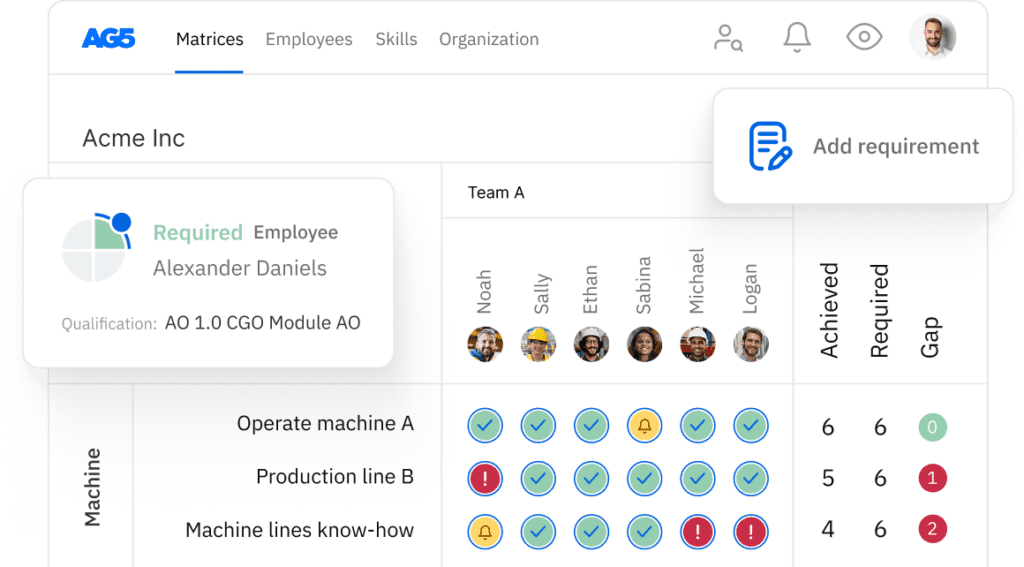Skill pool management: Why diplomas are so passé!
Discover the essence of skill pool management in this article, where we delve into its significance, advantages, and practical strategies for harnessing it to elevate organizational productivity and success.

It’s not all that long ago that most companies’ jobs and job descriptions were etched in stone. Each job title was accompanied by a clearly defined profile and a highly specific list of duties and responsibilities.
The era of static jobs is slowly, but surely coming to an end. Nowadays, more and more organizations operate using skill pools.
But what is a skill pool?Copied
Organizations are moving over to skill pools as a means to utilizing their staff’s talents more effectively and efficiently, but above all, more flexibly. Skill pools provide a quantitative and qualitative snapshot of the professionals working within your organization.
What are the foremost benefits to be reaped from a skill pool? And how do you go about implementing skill pool management?
High time we took a dive into the world of skill pools!
Where did the need or requirement for skill pools come from?Copied
For decades, the American engineer Frederick Taylor’s Principles of Scientific Management governed the way in which companies operated – hierarchical pyramids within which each individual was assigned a static, rigid job or job description.
In accordance with this model, HR tasks consisted mainly of drafting highly job-specific staff vacancy notices, targeting a certain type of candidate and leaving very little room for creative recruitment and selection. The career ladder within this type of organization also followed a highly predictable progression.
These days, this model no longer works as well as it used to for various reasons, the three main reasons being:
- professional emancipation
- labor market flexibility
- dynamics and advance of modern technologies
Nowadays, organizations are virtually being forced to undergo a paradigm shift in terms of their culture and thinking in order to attract top professionals from within the labor market.
If we zoom in even further, it’s possible to detect several modern-day insights and trends that have been driving the advent of skill pools, as well as the shift towards more flexible organizational structures.
- traditional job descriptions often have serious limitations
Rigid organizational structures are proving incapable of responding to ever-changing market conditions. Many modern companies are prioritizing flexibility, which in turn is prompting a shift from rigid, static job descriptions to dynamic, fluid skill pools. - rapid technological advances are replacing or changing traditional jobs
Technological advances have been blurring the lines between job descriptions that previously had been clearly defined. For example, methods such as Rapid Application Development (RAD) mean that application development is no longer the sole and exclusive domain of professional programmers. Moreover, modern communication technologies have been making it possible to tackle large-scale, cross-border projects. - companies and HR managers are focusing less on clearly defined job profiles
For example, soft skills are becoming increasingly important. What’s more, a rigid focus on ‘experience’ in a particular position is leading to blinkered vision and an increased likelihood of candidates being overlooked who might have hidden talents that would greatly benefit the company.
From static to dynamicCopied
These trends are resulting in greater flexibility with regard to jobs and a blurring of the boundaries between rigidly defined job descriptions.
Nowadays, teams no longer consist of employees with clearly defined static jobs, but of highly versatile and employable professionals with the right skill sets.
This means that someone with a broad skill set can use certain skills on Team A and others on Team B. Flexible teams are emerging with skill sets and compositions that can be carefully tailored to meet current requirements, processes, or customer needs.
What is skill pool management?Copied
Effective and efficient management is essential as jobs or roles become increasingly flexible in nature, especially in large, international organizations where a wide range of professional, ambitious, and highly motivated people are employed.
Many companies use skill pools to manage these professionals’ expertise, experience, and aspirations. Skill pools provide an insight into your staff population. What specialists do I have in-house? What can individual staff members offer? Which skills are present or lacking?
A characteristic of a skill pool is that its focus is directed towards an individual staff member’s total set of hard and soft skills (rather than a traditional job description), e.g. communication skills, social skills, linguistic skills, personal habits, attitudes, etc. Hence, the emphasis lies more on a palette of skills and traits than on clearly defined job profiles.
Managing your skill pool is the key to success in the current-day business landscape.
4 practical tips for skill pool managementCopied
How should you go about implementing skill pool management in practice?
High time we shared our top four tips!
1. Assessments
Making assumptions based on someone’s work history or job title means you often overlook their hidden talents. The solution involves gaining greater insight into their personal motivations and skills.
Assessments are an ideal means to achieving this. You’ll also have to invest in proper, one-on-one discussions. This is the only way for an HR manager to see the full picture.
By focusing on skills and personality, it becomes easier to determine who is suitable for which tasks, projects, or processes. The right job candidate isn’t necessarily the person with the right qualifications on paper.
2. Selection
You’ll need a selection method in order to put the right people in the right place at the right time and create high-performance teams – quickly and effortlessly. A skill pool offers numerous options for a transparent evaluation system.
For example, using digital badges or even skills matrices. In combination with the right software, it’s even possible to update matrices from the work floor based on your latest insights into skills, competences, or certification.
3. Transparency
Transparency is an important element of successful skill pool management. It’s critical that a wide range of people from across the entire company are involved in this process and that they see how you’re making these decisions.
This means that decisions can be clearly substantiated based on sound information from the skill pool.
4. Tools
The right tools are also important to maintaining an overview of the various skill pool management processes. Matrices in spreadsheets are adequate for simple situations, but soon become overly complicated and complex (jam-packed with mind-boggling formulas and links) as the skill pools become larger and more complex.
Special-purpose management software is the only solution to this problem. All information is stored centrally in the cloud but can be altered remotely from any location. This then allows you to find the right professionals for a project or the most suitable replacement for a specialist who’s on leave, at the click of a button.
It’s also possible for HR managers and staff to receive automated notifications. This allows both staff and management to take appropriate action before qualifications or certifications are about to expire.
The benefits of skill pool managementCopied
Skill pool management has a number of important benefits with respect to traditional recruitment strategies. Let’s zoom in on a few of these benefits.
Greater insight into existing expertise
Skill pools allow companies to determine more quickly and more easily whether they have sufficient expertise, talent, and experience in-house to complete a project or carry out a process.
Conversely, proper skill pool management allows companies to identify and respond to existing or imminent shortfalls (resulting from natural attrition or unexpected absenteeism). Appropriate responses may include retraining existing or recruiting new staff.
It also helps you to pinpoint key roles and to put contingency plans in place, e.g. identifying, retraining, or recruiting replacements for people filling these key roles.
Employee satisfaction
As a rule, skill pool management results in greater employee satisfaction. Most people like receiving personal attention and respond positively when they’re treated like a human being rather than a job description on two legs.
Better knowledge distribution
Skill pool management also improves the spread of knowledge, as it blurs the traditional boundaries between job titles causing information to be shared across a wider network of people.
This results in:
- reduced concentration of knowledge with certain individuals
- more people able to perform any given task
- fewer continuity problems when staff leave
A better distribution of knowledge also allows for greater flexibility and agility, as it becomes increasingly easy to put together knowledgeable, versatile teams ideally suited to performing a specialist task.
Greater insight into soft skills
Both soft and hard skills determine whether someone performs well on the work floor or feels comfortable in a particular role. Skill pools help identify soft skills.
Is a staff member an introvert or a more assertive type? Do they prefer to communicate by email or face to face? Do they like routine or are they inclined to seek new challenges? The answers to these questions often weigh as heavily as their hard skills when determining suitability for a certain task.
Skill pool management in large companiesCopied
More and more large, international companies are implementing skill pool management.
Take for example IBM’s Global Action Teams that tackle complex projects and consist of staff members picked from a wide range of disciplines.
Another example is Shell, which claims that it offers careers, not jobs, with staff moving from project to project wherever their skills are required.
Springest – the Netherlands’ largest marketplace for training courses and educational programs – operates entirely on the basis of Holacracy. This non-hierarchical, self-organizing system relies on skill pools. Hierarchies are replaced with ‘circles’ that share responsibility for completing projects without the need for managers.
Conclusion – skill pools are the futureCopied
The HR world is currently in a state of flux and transition. Recruitment based on rigid job descriptions and static jobs are making way for skill pools and interdisciplinary cross-pollination. Sound skill pool management also has the potential to optimize organizational structures.
Greater flexibility, higher employee satisfaction, and improved productivity are major benefits associated with these new working and organizational methods.
Drop us a line if you’d like advice on managing your skill pool, or you’re looking for software to implement skill pool management more effectively and efficiently.

